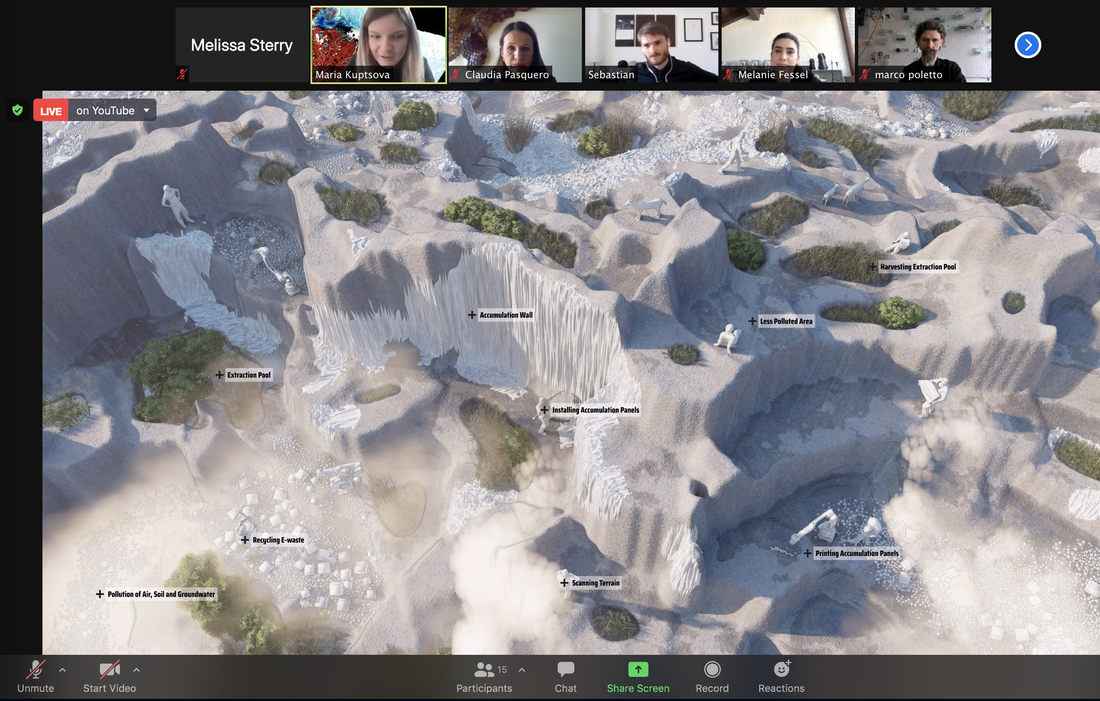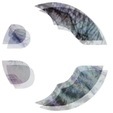|
On March 25th March I had the pleasure to join the University of Innsbruck's Synthetic Landscape Lab Final Thesis jury together with the lab's director, Prof. Claudia Pasquero and members including Maria Kuptsova who supervised the research projects, and fellow jurors cofounder and director of ecoLogic Studio Dr. Marco Poletto and ETH Zurich's Melanie Fessel. Working within the investigative conceptual framework of the lab, each of the projects presented explored the potentialities of an ecological intelligence through the convergence of all processes and systems - humans, animal, microbiological, technological and digital, that are currently accelerating the transformation of our Urbansphere. 'Agbogbloshie - The Landfill as Landscape' by Sebastian Partoll [seen above and below] examined the possibility of harvesting toxic chemicals that are leached when electronic goods, such as laptops, televisions, and smart phones, are disassembled, through the use of synthetic lichen-like growths in the landscape. Proposed as a means of mitigating a problem [pollution] while offering new economic and social opportunities [i.e. revenue from the sale of the chemicals harvested], the project was beautiful illustrated and animated, both in the live-stream presentation itself, and in Partoll's final dissertation. 'Atlas - Future Alpine Metropolitan Landscape' - Daniel Stiletto [seen second below] explored how augmentation of an Alpine landscape might simultaneously mitigate the issue of flooding, debris falls, and other geological failures, while harvesting water for both residential and industrial use. Through Stiletto's synthetic hydrological lens a critical problem has morphed into an ambitious, but through-provoking solution. Another elegantly executed project, Stiletto particularly impressed jurors with his sublime illustrations and unique visual style. 'The Physarum Game' by Thierry Lopes [seen bottom], spliced biological computing logic with electronic computing practice to create a game that educates citizens on how changes in the landscape human and non-human impact upon regional hydrology and thus water supply. Having chosen Cape Town as the locale for his concept, Lopes' exhibited a robust grasp of research practice, original thinking in his approach, as, as did Stiletto and Partoll, the ability to take on board the advisories of both course jurors and supervisors to deliver noteworthy works that met the highest standards in research and practice in their respective discipline. Well done to Sebastian, Daniel, and Thierry, together with Claudia, Maria, and the Synthetic Landscape Lab team, and fellow course jurors on, yet again, raising the bar in this critical research and practice domain.
0 Comments
Your comment will be posted after it is approved.
Leave a Reply. |
AuthorMelissa Sterry, PhD, chartered design scientist, systems theorist, biofuturist, and serial founder inc. Bionic City® Bionic CityAsking the question "how would nature design a city" since 2010.
Archives
October 2023
Categories#bionics
#biotech #biodesign #bioscience #biomimetics #biotechnology #bioengineering #bioinnovation #bioaesthetics #biorevolution #bioenterprise #biosystems #biocreative #biofuturism #biofutures #biocentric #biofacture #biotecture #biovation #biofiction #biourban #biocities #biolab #bioart #STEM
#STEAM #STEAMED #STEMcomms #STEAMcomms #STEAMEDcomms © Bioratorium Limited & Melissa Sterry
2021 All Rights Reserved |

 RSS Feed
RSS Feed

